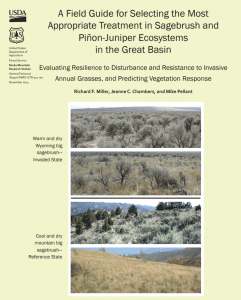Post-fire Environment & Management
View field guide.
This field guide identifies seven primary components that largely determine resilience to disturbance, as well as resistance to invasive grasses and plant succession following treatment of areas of concern. An evaluation score sheet is included for rating resilience to disturbance and resistance to invasive annual grasses and the probability of seeding success.
View fact sheet.
This fact sheet from the Sage Grouse Initiative discusses a new soils product that provides the ability to depict potential ecosystem resilience and resistance across the range of sage-grouse using soil temperature and moisture regimes.
View brief.
This brief highlights a study that found rodents foraged differently in burned and unburned areas. They took seeds and ate seedlings from unburned areas. They were more likely to leave seeds and seedlings in the burned areas.
View fact sheet.
This fact sheet summarizes findings from a study comparing insect populations in burned and unburned areas. The study showed greater reproductive success for isolated plant survivors of generalist species, and less success for specialist species. The more specialized your reproductive strategy, the harder fire is on your sex life.
View report.
This report, developed by the Western Association of Fish and Wildlife Agencies (WAFWA), Wildfire and Invasive Species Initiative Working Group (Working Group), summarizes the current state of Fire Operations and Fuels management functions in big sagebrush communities. The intent of this report is to illustrate the type and responsiveness of efforts being made. Finally, the report concludes by presenting future options and a series of recommendations that may inform future policy and allocation decisions.
View report.
This report synthesizes current information on the effectiveness of post-fire seeding for both soil stabilization and for prevention of the spread of invasive species in rangelands. This information will help federal land managers make more cost-effective decisions on post-fire stabilization and rehabilitation treatments.
View synthesis.
In this review of recent literature and meta-analysis of seeding after wildfires, the authors found that seeding has little effect on erosion during the first year after fire and is highly dependent upon initial establishment and coverage of species in successive years. Older seedings were more likely to show reductions in invasives than younger seedings. Seedings with high plant establishment were more likely to reduce invasives than those with low establishment.
View article.
This Nature article discusses large, severe fires, climate change, insect outbreaks, and recovery of western forests with USGS scientist, Craig Allen and WERC scientist, Nate Stephenson. on the conversion of forest ecosystems due to climate change and altered fire regimes.
Climate change, forests, fire, water, and fish: building resilient landscapes, streams, and managers
View report.
This report describes the framework of how fire and climate change work together to affect forest and fish communities. Learning how to adapt will come from testing, probing, and pushing that framework and then proposing new ideas. The western U.S. defies generalizations, and much learning must necessarily be local in implication. This report serves as a scaffold for that learning. It comprises three primary chapters on physical processes, biological interactions, and management decisions, accompanied by a special section with separately authored papers addressing interactions of fish populations with wildfire.
View guide.
This is an online guide to legal and institutional resources intended to serve as a starting point to help public and private land managers figure out which considerations are most relevant to the implementation of vegetation treatments in Great Basin states.


